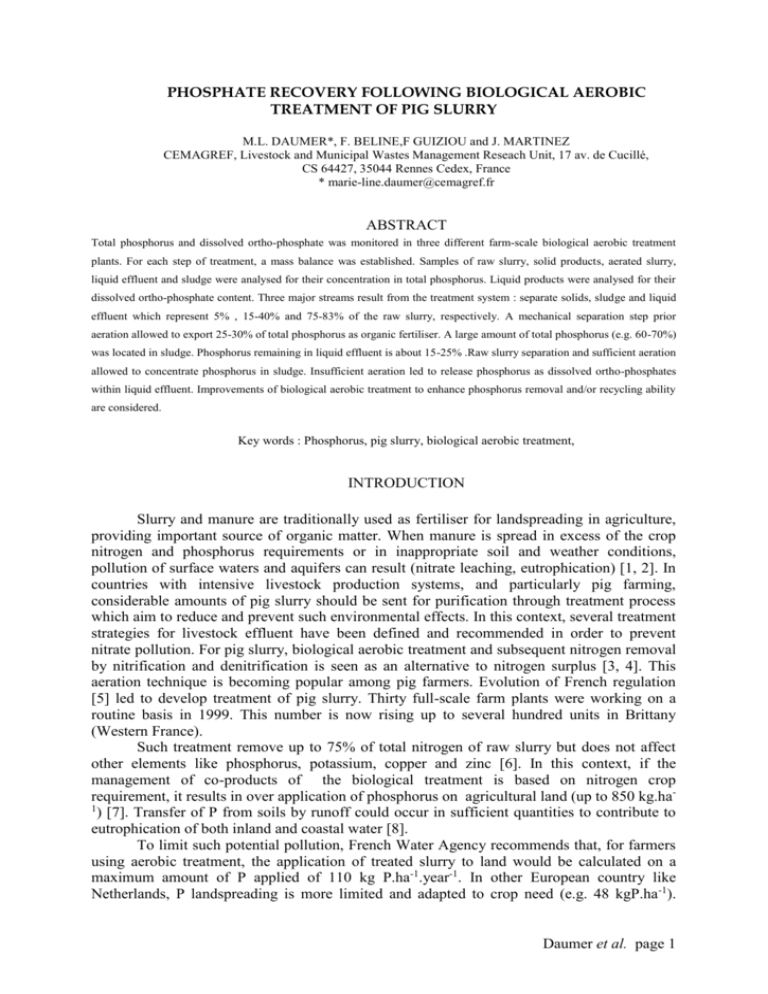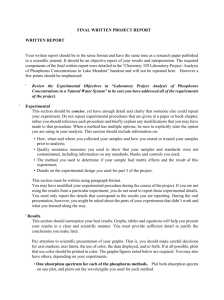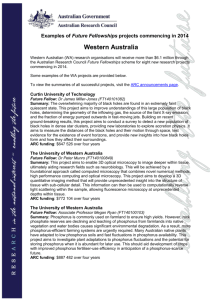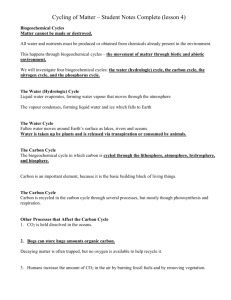Daumer
advertisement

PHOSPHATE RECOVERY FOLLOWING BIOLOGICAL AEROBIC TREATMENT OF PIG SLURRY M.L. DAUMER*, F. BELINE,F GUIZIOU and J. MARTINEZ CEMAGREF, Livestock and Municipal Wastes Management Reseach Unit, 17 av. de Cucillé, CS 64427, 35044 Rennes Cedex, France * marie-line.daumer@cemagref.fr ABSTRACT Total phosphorus and dissolved ortho-phosphate was monitored in three different farm-scale biological aerobic treatment plants. For each step of treatment, a mass balance was established. Samples of raw slurry, solid products, aerated slurry, liquid effluent and sludge were analysed for their concentration in total phosphorus. Liquid products were analysed for their dissolved ortho-phosphate content. Three major streams result from the treatment system : separate solids, sludge and liquid effluent which represent 5% , 15-40% and 75-83% of the raw slurry, respectively. A mechanical separation step prior aeration allowed to export 25-30% of total phosphorus as organic fertiliser. A large amount of total phosphorus (e.g. 60-70%) was located in sludge. Phosphorus remaining in liquid effluent is about 15-25% .Raw slurry separation and sufficient aeration allowed to concentrate phosphorus in sludge. Insufficient aeration led to release phosphorus as dissolved ortho-phosphates within liquid effluent. Improvements of biological aerobic treatment to enhance phosphorus removal and/or recycling ability are considered. Key words : Phosphorus, pig slurry, biological aerobic treatment, INTRODUCTION Slurry and manure are traditionally used as fertiliser for landspreading in agriculture, providing important source of organic matter. When manure is spread in excess of the crop nitrogen and phosphorus requirements or in inappropriate soil and weather conditions, pollution of surface waters and aquifers can result (nitrate leaching, eutrophication) [1, 2]. In countries with intensive livestock production systems, and particularly pig farming, considerable amounts of pig slurry should be sent for purification through treatment process which aim to reduce and prevent such environmental effects. In this context, several treatment strategies for livestock effluent have been defined and recommended in order to prevent nitrate pollution. For pig slurry, biological aerobic treatment and subsequent nitrogen removal by nitrification and denitrification is seen as an alternative to nitrogen surplus [3, 4]. This aeration technique is becoming popular among pig farmers. Evolution of French regulation [5] led to develop treatment of pig slurry. Thirty full-scale farm plants were working on a routine basis in 1999. This number is now rising up to several hundred units in Brittany (Western France). Such treatment remove up to 75% of total nitrogen of raw slurry but does not affect other elements like phosphorus, potassium, copper and zinc [6]. In this context, if the management of co-products of the biological treatment is based on nitrogen crop requirement, it results in over application of phosphorus on agricultural land (up to 850 kg.ha1 ) [7]. Transfer of P from soils by runoff could occur in sufficient quantities to contribute to eutrophication of both inland and coastal water [8]. To limit such potential pollution, French Water Agency recommends that, for farmers using aerobic treatment, the application of treated slurry to land would be calculated on a maximum amount of P applied of 110 kg P.ha-1.year-1. In other European country like Netherlands, P landspreading is more limited and adapted to crop need (e.g. 48 kgP.ha-1). Daumer et al. page 1 Consequently, implementation of this limit requires a land surface equivalent or superior to the land needed for nitrogen spreading without treatment. Recovery of P in a form suitable for crops and easy to handle as fertiliser offers an opportunity to better control the application of P and reduce overall P use in agricultural system by recycling it. This requires to concentrate this element in a solid form available for storage and transport. Actually, raw pig slurry separation is widely used and allows to obtain a product with total solid equal to 30-35% which contains between 15-25 % of initial total phosphorus. Only a few biological treatment plants, equipped with a vacuum filtration system for sludge, recover and export 80-85% of initial total phosphorus. Sludge is concentrated, mixed with others wastes, dried and exported like organic fertiliser. However, 15-25% of total phosphorus, mainly as soluble phosphorus, is remaining in liquid effluent and is spread on local area [9]. This form of phosphorus is of particular concern for the receiving water bodies because it is easily dissolved by runoff [10] and immediately available for uptake by algae and aquatic plants. In this context, a better characterisation and understanding of the evolution of different forms of phosphorus during aerobic treatment of pig slurry may help us to identify further treatment strategies to enhance phosphorus recovery, to evaluate environmental impact of coproducts and optimise management of the livestock effluents. The aim of this study is to assess the impact of three different type of treatment plant, running on a full-scale operation in Brittany, on i) distribution, ii) evolution and iii) recovery of total phosphorus. Moreover, dissolved phosphorus, especially ortho-phosphates were measured in liquid co-products in two units. MATERIALS AND METHODS Plant design and operation The three treatment units monitored were located near Lamballe (Brittany, France). For each of them, the main production characteristics of the pig farms are given in table 1. Table 1. Saws (total) Productive saws Weaned pigs in a year Post-wean places Pigs in a year Fattening places Farm units characteristics 1 363 286 7200 960 4500 1200 2 392 346 7752 1800 6266 1592 3 420 346 8332 1226 7986 2230 The first (unit 1) was designed to treat 19 m3 of slurry.d-1. Raw slurry is collected and mixed in a reception pit (340 m3) with alternative mixing. Every hour, raw slurry (0.4-0.6 m3) is pumped up to the aeration reactor (965 m3) which is equipped with two suction aerators of 22 kW each. Each aerator runs alternately during 15-20 min. Between each aeration sequence, there is an anoxic phase (15-20 min) . To maintain a constant level in the reactor, aerated slurry is discharged by gravity to a decantation tank. Sludge is pumped every 12 h during 3 min and sent to a storage tank (1500 m3). Liquid phase is transferred by gravity to a lagoon. Daumer et al. page 2 The second (unit 2) was designed to treat 18 m3 of slurry.d-1. Raw slurry is collected and mixed in a reception pit (300 m3) with alternative mixing. Every 3 hours, raw slurry is pumped up and mechanically separated by a press-auger. Separated solids are weighed and stored in a shed. Separated slurry is transferred by gravity to the aeration reactor (680 m 3) which is equipped with two surface aerators (18,5 kW each). The first one is controlled by a timer (1h/cycle), while the second has an authorised period and runs only when ORP is low. To maintain a constant level in the reactor, aerated slurry is automatically discharged to a decantation tank. Liquid phase is transferred by gravity to a lagoon. Sludge is stored in a separate tank (1770 m3). The third (unit 3) was designed to treat 16 m3.d-1 of raw slurry. Raw slurry is collected and mixed in a reception pit with continuous mixing. Slurry is then mechanically separated by a press-auger. Separated solids are weighed and stored in a shed. Liquid phase is settled in a decantation tank and the separated slurry is transferred by gravity to a buffer tank while sludge is sent back to the press-auger separator. Hydraulic residence time in this separation equipment is 5 days. Once a day, at the beginning of anoxic stage, separated slurry is pumped up to the aeration reactor (960 m3) which is equipped with fine bubble diffusers supplied by two compressors (9kW each). The first one is controlled by a timer (20h.d-1), while the second has an authorised period during the night and runs only when dissolved oxygen was below 1 mgO2.l-1. To maintain a constant level in the reactor, aerated slurry is automatically pumped, mixed with a polymer and sent to a vacuum sieve-belt separator. Liquid phase is transferred by gravity into a 0,5 m3 holding tank and was pumped and sent to a lagoon, sludge was kept in the same shed than separated solids. Schedule of this sophisticated unit is presented in figure 1. The three plants were equipped with weighing machine and flow meters to calculate the co-products flows. pH, temperature and oxydo-reduction potential (ORP), especially to follow anoxic and aerobic stages during treatment, were continuously monitored. 3 9 1 1 5 Figure 1. 2 1 9 5 4 2 10 0 3 6 7 7 1 4 6 8 8 Biological aerobic treatment plant (unit 3) : 1 : Reception pit ; 2 : mixer ; 3 : press-auger ; 4 : decantation tank ; 5 : shed ; 6 : buffer tank ; 7 : biological reactor ; 8 : fine bubble diffusers ; 9 : vacuum sieve-belt ; 10 : lagoon. Daumer et al. page 3 Sampling: Weekly during 8 consecutive weeks, raw slurry (RS) was sampled in the reception pit, through stirring of at least 30 min. Solid phase (SP) and separated slurry (SS) samples were taken directly from press-auger. Aerated slurry (AS) was sampled in the reactor while slurry was mechanically stirred, during aerobic stage for unit 1 and 2, or during anaerobic stage for unit 3. Sludge (S) was sampled just before the storage tank for the unit 1. For unit 2, decantation tank is used as intermediate storage tank, so it was not possible to sample sludge just after separation. Sludge was then obtained from a laboratory centrifugation. In unit 3, sludge was sampled directly from the sieve-belt separator. Liquid effluent (LE) was sampled between the decantation tank or between the sieve-belt separator and the lagoon. For dissolved ortho-P evolution, an analysis was done on liquid products sampled as above. Another sample was taken, the same day, in the lagoon as far as possible from receiving point, it was called spread effluent (SE). Only unit 1 and 2 were studied. Analysis : Samples are prepared as required by French standard NF U 42-090. Analysis of total solids (TS), total suspended solids (TSS), volatile solids (VS), volatile suspended solids (VSS), total Kjeldahl nitrogen (TKN), ammoniacal nitrogen (NH4) were performed using current laboratory methods. Nitrite, nitrates and dissolved ortho-P were measured by ionic chromatography . Total phosphorus (total-P) was analysed with spectrophotometric method (430 nm) after dry ashing and dissolution in nitric and chlorhydric acid following by a colouring reaction with ammonium molybdate vanadate. These analysis were performed by the Laboratoire de Développement et d’Analyses (LDA) located in Ploufragan (22, France) . RESULTS The loss of nitrogen confirms that more than 60%-70% of initial nitrogen was transformed as nitrogen gaseous forms during biological aerobic treatment. Consequently, removal of 49% and 90% of the total and soluble COD were observed respectively. Mass balance and distribution of co-products A mass balance was established at the different stage of the treatment by sampling each input and output flow (Figure 2). On a weigh basis, mass balance was closed to 100% (min : 94 ; max : 113%). Similar results were obtained for the total solids (TS) except for unit 3. For this unit, recovery of total solid is around 75%. Similar discrepancies observed for other compounds may be explained by natural sedimentation at the bottom of the biological reactor for this unit. The mass of liquid effluent varied from 75 % of the initial product for the unit 1, to 83 % for the unit 3. With a mechanical separation following the biological reactor (unit 3), sludge represented 10% of the mass of raw material while this phase represents 37 % with decantation only (unit 1 and 2). Because of sludge separation in laboratory, data for the unit 2 are not presented but were probably closed to the result obtain for the unit 1. For unit 2 and 3, separated solid from press-auger represent about 5% of initial mass of slurry. Daumer et al. page 4 Recovery (%) Unit 1 Unit 3 120 100 80 60 40 20 0 Mass recovery Figure 2. Unit 2 Separation of Biological Separation of raw slurry reactor aerated slurry Mass balance at the different steps of the treatment Distribution of phosphorus Distribution of total-P in these co-products is illustrated by Figure 3. A large amount of total phosphorus was located in the sludge (60-70%), while 25-30% was found in separated solids. Phosphorus remaining in liquid effluent was about 15 % and 25 % for unit with and without separation of raw slurry, respectively. %PRS 150 S LE SP 100 50 0 Unit 1 Figure 3. Unit 2 Unit 3 Distribution of total-P in co-products Table 2 shows phosphorus concentration in each co-product. Press-auger allows to increase almost fivefold the concentration of total-P in the solid product. Mechanical separation following aeration allows to increase fourfold the concentration of phosphorus in solid product compare with decantation only. Table 2. Raw slurry Separated phase Aerated Slurry Sludge Liquid effluent Total-P concentration in products (kgP.t-1) Unit 1 1.22 1.1 1.96 0,39 Unit 2 1.09 5.41 1.1 4.37 0.22 Unit 3 0.96 5.85 0.9 6.55 0.13 Daumer et al. page 5 Evolution of dissolved Ortho-P during the treatment : Figure 4 describes evolution of dissolved ortho-P and total-P in the liquid fraction during the treatment process. Other forms Ortho-P 1,5 -1 1 g.l Reception Pit 0,5 0 RS Unit 1 Unit 1 Unit 2 Unit 2 SS RS g.l-1 1,5 1 0,5 0 Unit 2 1,5 g.l -1 Reactor 0 AS LE g.l Lagoon Unit 2 Unit 1 Unit 2 Unit 1 Unit 2 0,4 0,2 0 SE -1 0,6 g.l Fields Unit 1 0,6 -1 Sludge storage tank 1 0,5 0,4 0,2 0 Figure 4. Evolution of total P and dissolved ortho-P during biological aerobic treatment of pig slurry. At the beginning of the treatment total-P and dissolved ortho-P are present in the same proportion in the two farms. Concentration of total-P is 1,2 kgP.t-1 for the unit 1 and 1,1 kgP.t1 for the unit 2, among which about 10% of dissolved ortho-P. Fraction of dissolved ortho-P in slurry has increased threefold with the mechanical separation (10 to 30 %). Part of dissolved ortho-P increased fourfold between input and output of the bilogical reactor in unit 1 (10 to 40 %). In opposite, it is twice divided in the unit 2 (30 to 15 %). Evolution during storage in the lagoon is similar for the two units, dissolved ortho-P is reduced by an half during this anaerobic stage. Table 3 presents ortho-P concentration in co-products. Daumer et al. page 6 Table 3. Ortho-P concentration in liquid products (kgP.t-1) ; Raw slurry Separated slurry Aerated slurry Liquid effluent Spread Effluent Unit 1 0.128 0.441 0.262 0.108 Unit 2 0.113 0.303 0.167 0.200 0.098 DISCUSSION Phosphorus content of raw slurry was about 1 kgP.t-1 and is in agreement with data given in the literature [7, 8, 11]. Phosphorus recovery by press-auger (25-30%) was consistent with previous results on separation efficiency (e.g. 7-33%) [12, 13]. Only 7% of separation efficiency was obtained by Pieters et al. [14] with the same equipment, probably due to the low content of TS of the slurry used in their experiment. Total nitrogen and total-P concentrations in solid product were 7.3 kgN.t-1 and 5.41 -1 kgP.t respectively for unit 1 and 8.2 kgN.t-1 and 5.85 kgP.t-1 respectively for unit 3. Nitrogen to phosphorus ratio is lower than crop requirements, but this product can be used as phosphorus amendment. For unit 3, separated solid from the first step is mixed with sludge obtained by the mechanical separation which follows biological treatment. Concentration in this mixed product, estimated from concentration and mass of each product is about 6.5 kgP.t-1. Phosphorus recovery obtained by mixing sludge and separated solid is about 80-85%. At the present time, this product is mixed with other waste, dried and used as fertiliser. No data are available on this process, so it is not possible to assess this process in term of quality of product reuse and economic sustainability. In unit 1 and 2, the low dry matter of the sludge obtained after decantation of aerated slurry did not allow to export this product. Also this sludge is locally spread. The spreading of this product, led to amount of phosphorus widely higher than crop requirements. In this context, the improvement of P recovery seems to be required. Concerning the P remaining in liquid effluent which represent about 15%-25%, the total amount is applied locally. Spreading this product in respect with agricultural requirements needs large area ( 2-6 ha for 1000 m3 of liquid effluent). At the present time, there is no regulation. French water agency recommend to spread only during raining deficiency period which is not always achievable in countries like Brittany. Due to the local meteorology, liquid effluent is often spread, when the lagoon is full, on a small area just around the treatment unit. This management, imposed by technical constraint of automatic irrigation, could led to runoff of phosphorus. New strategies to enhance phosphorus recovery from products of biological aerobic treatment of slurry have to be developed. In this purpose, other equipment like decanter centrifuge could improve the phosphorus recovery, up to 80% of phosphorus with suitable technology. However, this technique doesn’t allow recovery of soluble phosphorus. Specific energy consumption for this equipment is twice than for a press-auger [12]. Phosphorus recovery by accumulation in sludge in treatment of waste water process has been widely reviewed by Mino et al [15]. Enhanced biological phosphorus removal (EBPR) is achieved by successive anaerobic and aerobic step. During anaerobic stage, when no electron acceptors (like oxygen and nitrate) are present, the phosphorus removing bacteria take up less fatty acid such as acetic acid and store them as polyhydroxy-alkalanoates. The Daumer et al. page 7 energy for this process is derived from glycogen conversion and the stored polyphosphates by hydrolysis and excretion of phosphate. Following this stage, in the aerobic period, oxygen is used as an electron acceptor for the oxidation of stored polyhydroxyalkalanoates, which leads to phosphate uptake for polyphosphate regeneration [16]. Biological aerobic treatment of pig slurry process alternate aeration and anoxic stage to allow nitrification and denitrification of ammoniacal nitrogen. Although biological phosphorus removal in aerobical treatment of pig slurry has never been described, the difference between unit 1 and unit 2 for the evolution of soluble phosphorus in biological reactor could be partly explain by this process. The main difference between the two units is due to aeration. The insufficient aeration observed for the unit 1is well correlated with the ORP, often comprised between - 350mV and 0 mV even during aeration stage, and oxidised forms of nitrogen present is mainly as nitrites. Aeration and anoxic stages are very short and metabolism cannot be established. For example, nitratation, which is the second phase of nitrification does not occurs. Moreover, nitrites could be implied in phosphorus uptake inhibition [17]. In opposite, the minimum ORP of unit 2 varies from -300mV (anaerobic conditions) to –50mV (anoxic conditions), in relation with DCO brought by raw slurry, without aeration. It rises 200 mV when aerators were running. Anaerobic or anoxic and aerobic stages are clearly defined. Metabolism of similar nature to EBPR could be induced. However , further trials are needed to confirm this assumption. From these observations, two opposite strategies for recovery phosphorus during aerobic treatment could be taken under consideration : i) concentrate phosphorus in sludge which will be strongly separated and exported, if a sustainable market is developed. ii) release phosphorus under a soluble form in liquid effluent and recover it as a useful form. Results obtained concerning evolution of dissolved phosphorus concentrations for unit 1 and 2 show that aeration strategy could strongly influence concentration of dissolved ortho-P. NH4 and PO4 concentrations in liquid effluent are 8.6 x 10-3 and 6.5 x 10-3 mol.l-1 respectively for unit 1 and 7.1 x 10-4 and 6.5 x 10-3 mol.l-1 respectively for unit 2. This correspond to a NH4: PO4 ratio of approximately 1.3 : 1 for unit 1 and 0.1 : 1 for unit 3. Therefore, it is possible to precipitate phosphorus as struvite, obtained if magnesium, ammonium and phosphate are in equal (stoichiometric) proportions in a pH range from 7 to 11 (9 being the pH of minimum solubility) [18]. This form of phosphorus can be use directly as a slow-release fertiliser and would therefore be directly used in the farm or sold as a valuable waste by-product . This process has been tested to remove phosphorus from anaerobic swine lagoon effluent [18], but, due to the high ammonium concentration of, raw slurry, it seems not to be a valuable approach as regard to the high cost for chemicals (Magnesium and phosphate) and operation [12]. In our case, effluent is denitrified and phosphate would not be a limiting factor. Precipitation of potassic struvite is another way possible. This process has been studied for anaerobic swine lagoon effluent and denitrifies calf manure [19]. It is used to remove P from a denitrified calf-manure in a farm-scale treatment plant in Netherlands [18]. In this case, waste has been nitrified and denitrified, potassic struvite (KMgPO4) is formed. Potassium concentration in liquid effluent from biological treatment of pig slurry is generally about 5 x 10-2 mol.l-1 [9] . It could replace ammonium for struvite precipitation and be removed from liquid effluent, in which high concentration is another environmental concern. However, magnesium and potassium were not quantified in this first study, therefore magnesium was the limiting constituent and had been added in process to remove phosphorus from anaerobic swine lagoon effluent and denitrified calf manure. Daumer et al. page 8 Another way to improve P recovery is to precipitate the remaining phosphoric compounds with lime milk. About 35 to 40 kg CaO per m3 of slurry has to be added to the liquid effluent obtained by aerobic biological treatment. After precipitation, phosphorus concentration in the clarified liquid can be less than 2 mg.l-1 [12] CONCLUSIONS This preliminary study allowed us to evaluate biological treatment of slurry in term of phosphorus recovery and environmental risk. Phosphorus distribution in final co-products depends on the evolution of different forms, dissolved or not, during treatment. This evolution could be induce by aeration strategies. Sufficient aeration allows to concentrate phosphorus in sludge, while insufficient aeration led to release soluble phosphorus. As a consequence of these results, two strategies for P recovery seems possible : i) increase P uptake during aeration and improve sludge separation. ii) increase P release and develop specific treatment . If potassic struvite could be formed, this approach would become a mean to recover potassium too. Further studies are necessary to confirm these results and get better knowledge of phosphorus transformation during aerobic treatment of pig slurry to define which treatment strategy is the most suitable and thus, optimise recovery of phosphorus under a valuable form. ACKNOWLEDGEMENTS This project was co-funded by the Water Agency and the Regional Council of Brittany. We are grateful to the manufacturers and farmers for access to the plants. REFERENCES 1. Robinson J. S. and Sharpley A. N., Release of Nitrogen and phosphorus from Poultry Litter. J.Environ.Qual., 24, 62-67 (1994) 2. Smith K. A., Chamers A. G., Chambers B. J. and Christie P., Organic manure phosphorus accumulation mobility and management. Soil Use and Management, 14, 154-159 (1998) 3. Beline F., Martinez J. and Burton C., Traitement aérobie du lisier de porcs. Bases théoriques et techniques. Vecteur Environnement, 31, 38-48 (1998) 4. Gitton C. and Hurvois Y., Importance of treatment in reducing surplus manure policy. In: Proc.of the conference on Comment concilier production porcine et protection de l'environnement. March 1999, Paris.J.B.Montalescot (Ed.), Cemagref, Paris, pp.115-130 (1999) 5. Decree n° 2001-34, J.O de la République Française. 11 (2001). 6. Martinez J., Burton C. H., Sneath R. W. and Farrent J. W., A study of the potential contribution of sedimentation to aerobic treatment processes for pig slurry. J. agric. Engng Res., 61, 87-96 (1995) 7. Fardeau J. C. and Martinez J., Epandages de lisiers: conséquences sur le phosphore biodisponible et sur la concentration de quelques cations dans la solution du sol. Agronomie, 165, 153-166 (1996) 8. Greaves J., Hobbs P., Chadwick D. and Haygarth P., prospect for the recovery of phosphorus from animal manure : a review. Environmental Technology, 20, 697-708 (1999) 9. Béline F., Daumer M.L, Guiziou F.and Rapion P., Bilan de fonctionnement des unités de traitement biologique aérobie du lisier de porcs : Etude des flux de matières et compréhension des processus, study report, Cemagref (2000) Daumer et al. page 9 10. Sharpley A. N., Smith S. J., Jones O. R., Berg W. A. and Coleman G. A., The transport of bioavailable phosphorus in agricultural runoff. J.Environ.Qual., 21, 30-35 (1992) 11. Coppenet M., L'épandage du lisier de porcherie. Ses conséquences agronomiques.Ann. Agron.,25,403-423 (1974) 12. Martinez J. and Burton C., Processing strategies for farm livestock slurries to minimize pollution and to maximize nutrient utilization : a European perspective. In: Proc. of the Int. Workshop on Environmentally Friendly Management of Farm Animal Waste. 1998. T.Matsunaka (Ed.), pp.179-189 (1998) 13. Moller H. B., I. Lund and S. G. Sommer, Solid-liquid separation of livestock slurry : efficiency and cost. Bioresource Technology,74,223-229 (2000) 14. Pieters J. G., Neukermans G. G. J. and Colanbeen M. B. A., Farm-scale membrane filtration of sow slurry. J.Agric. Engng Res., 73, 403-409 (1999) 15. Mino T., VanLoosdrecht M. C. M. and Heijnen J. J., Microbiology and biochemistry of the enhanced biological phosphate removal process. Wat.Res., 32, 3193-3207 (1998) 16. Kuba T., Murnleitner E., Van Loosdrecht M. C. M. and Heijnen J. J., A metabolic model for biological phosphorus removal by denitrifying organisms. Biotechnology and Bioengineering, 52, 685-695 (1996) 17. Meinhold J., Arnold E. and Isaacs S., Effect of nitrite on anoxic phosphate uptake in biological phosphorus removal activated sludge.Wat.Res.,33,1871-1883 (1999) 18. Nelson N. O., Mikkelsen R. L. and Hesterberg D. L., Struvite formation to remove phosphorus from anaerobic swine lagoon effluent. In : Proc. of the 8 th Int. Symposium on Animal, Agricultural and Food Processing Wastes. Oct.2000, Des Moines, Iowa.J.A.Moore (Ed.), ASAE, St Joseph, Michigan, pp.18-26 (2000) 19. Schuiling R. D. and Andrade A., Recovery of struvite from calf manure.Environmental Technology, 20, 765-768 (1999) Daumer et al. page 10





